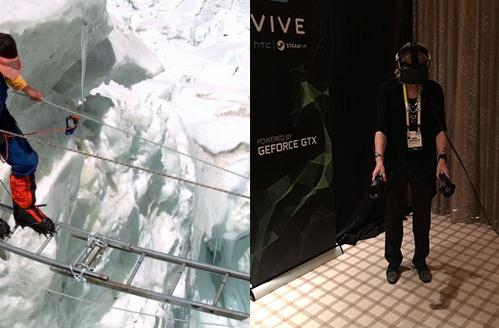Nvidia Virtual Reality Demos Takes You on Adventures

This morning I climbed Mt. Everest and floated outside the space station over earth. Of course, I was actually in the Nvidia suite at CES, but my experience was that of having a grand adventure. Nvidia demo’d two different Virtual Reality headsets to showcase the company’s video card capabilities and how well they handle VR.
Virtual Reality headsets submerge the user into a computer-generated world where they are completely surrounded 360 degrees vertically and horizontally. Goggles seal around the eyes and are held with a band around the head. Headphones add surround sound and the user holds a controller to interact with the virtual environment as well moving the head and body to look and walk around in the virtual world.
To run virtual reality on a computer requires seven times the video processing power of regular video. Nvidia announced that its GEForce GTX VRReady program would place badges on computers that meet or exceed the minimum requirements to run virtual reality at the needed 90 frames per second without latency or stuttering. This will help potential computer buyer’s to know if a computer will be able to run VR software.
Having read books about Mt Everest, I was eager to give Solfar Studios’ Everest experience a try. The virtual world was created using footage from the recent Everest movie. Everest was experienced in an empty room using the HTC Vive VR headset, headphones and special controllers which create virtual beams of light for choosing menus and allows you to see the position of your hands in the virtual world.
Starting at base camp, I looked out over the Himalayas as we took a helicopter ride to the Khumbu Icefalls where ladders are used to cross crevasses that fall hundreds of feet. The hand controllers became my mittened hands that reached down for the ropes to help guide me over the ladder. The experience was truly as if I were there. Ice breaking beneath my feet and falling into the deep abyss, only magnified the sense of how far I could virtually fall with a misstep. Of course I couldn’t fall. This isn’t real. But try to tell my brain that. When I reached the other side there was a virtual fellow climber who was “standing” close to me. I gave him a virtual hug then ventured up the 100 plus foot ladder to the next ice cliff (a feat, I was told, several others could not make themselves complete). While my fear of heights crept into my body, I told myself I was safe (as I do in real life when hiking). I stopped to take a look down and around, feeling quite brave.
At the top, the view was stunning. I could see the summit of Mt. Everest and felt what it must be like—a mixture of excitement and fear—in the real world to see the top of the peak so close and yet realize how incredibly difficult the final assent would be. The world may have been virtual but my feelings were quite real. For fun, I ordered my mind to step “off” the edge of a cliff. It took every ounce of willpower to convince myself that the floor was still beneath me and I would be safe to walk on air. Although I could have spent my day climbing to the top of Everest, I had to move on to the next demo.
The second demo was experienced while sitting at a desk in front of a PC, which is more likely how most people will use a VR headset. The Oculus Rift VR headset with attached headphones was used to play the upcoming space game, Adr1ft. While it is a game about an astronaut who must deal with a destroyed space station, I chose to just enjoy floating in space. After learning how to use my thrusters (accomplished using an Xbox game controller), I ventured out into space and floated around in awe as I positioned myself to view the Earth, oceans and landmasses below. As I looked around with awe, wonder, and a touch of nausea from tumbling because of my inability to stabilize using the thrusters, I was content to identify the long land of Baja California and up toward North America.
The Oculus Rift became available for pre-order starting January 6th with deliveries beginning March 28. The release date of the Everest and Adr1ft games are also March 28. The VR headset is priced at $600 ###








































